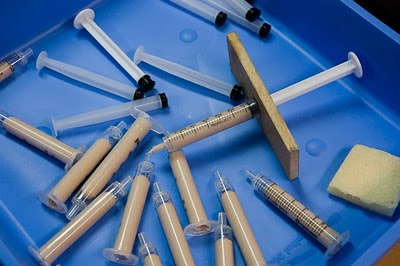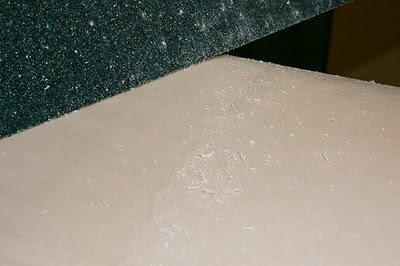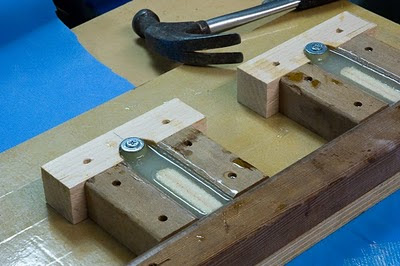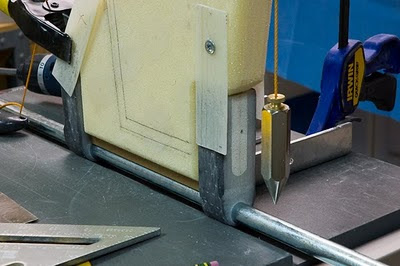After that initial sand, I still had some problems with several low areas: around the attachment of the foam bow, and the transition of more round/full keel towards the sharper entry area. I decided a skim coat would be easiest. I also spot-filled some bubbles.
(This is an area that has been problematic in varying degrees on all four float sides, and I've seen others comment also. I have two ideas. The reflection of extra glass at the bow entry leaves a low spot behind, and I've been too aggressive at sanding down the stripes in this transition area from full/round to flat/vertical. Or the root problem may also be how the forward end of the float is constructed. The battens near the keel make a difficult twist in a compound curve as they approach form #1 - this may make this area shallow. A more careful investigation when attaching the foam cap and fairing the foam could alleviate this problem.)
I have a constant supply of used, but clean syringes from work. I cut off the Luer-lock to make a fine point, use a couple of reusable ergonomic modifications to save my hands, and fill them with a Ziploc bag. With these I can fill the small Dremel bur depressions left from attacking the bubbles with minimal effort or material.
I did the deck in a similar fashion as the first float. First I put on a single skim coat, working the material with significant force to work out any bubbles. I'll admit this is more successful than on the sides with the candy stripes.
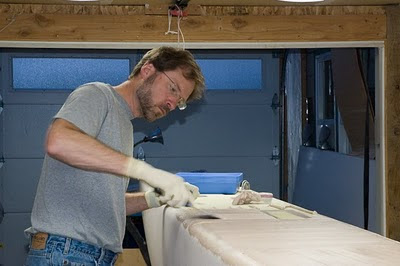

I modified my sanding by trying the 'cheese grating' technique described by Wayne Hicks. Essentially you begin sanding while it's still soft - when it deforms with a thumb nail, but isn't tacky.
The idea is different enough that I was sure it wouldn't work . . . but it does.
Shortly after I finished applying the QuickFair I was able to begin sanding with 36 grit (at the bow where I had started) and slowly worked towards the stern while it continued to cure. The material came off in soft clumps that did not clog the sandpaper and were easily brushed off. Interestingly, the heat of the sanding seemed to speed the cure as I moved along. It was a great time saver to remove the majority of excess QF - and there was no dust! Unfortunately, I can't see how I could incorporate this technique to larger curved areas, as I couldn't apply it fast enough with the short cure time of QF.
Nearly finished except small detail areas.
After working with the soft QF during the 'cheese grating' I tried several other variations on this idea. One was obvious - cut off the tops of any filled Dremel divots with a wide chisel. This negated any effort trying to sand them without lowering my finished QF level.
I also found a couple of areas that were low from the edge of the trowel during the skim coat of the deck. Attempts to fill this type of area before had either left it low by trying to minimize the amount, or required extra effort to sand down without hurting the surrounding material. To fill these high, I put tape around the defect and skimmed over the top. This left the QF patch elevated by the uniform thickness of the tape. When strong enough to not tear, but soft enough to cut, I used a chisel and easily removed the excess.
Both these techniques took care of the last minute touch-ups before I began the final sanding to get it to that 'thin as possible' state.
I used the same skim coat followed by two coats of raw epoxy as required to seal the QF.
I have been working hard to get the floats to a stopping point before June. So, though they have a ways to go, this is how they'll sit.
Between steps I also continued to work on smaller parts. Here are the gudgeons as made in the mold.
My previous experience of vacuuming after wrapping carbon around an edge had not been perfect. As the excess resin is removed and as the fibers are compressed, they are not pulled tighter around the edge, but instead make a small wave or wrinkle. I decided to do a hand lay-up and let gravity pull the peel ply over the carbon. I've also found that making the part slightly larger and cutting to size makes the finished carbon uniformly thick out to the edges.
Gudgeons being fitted on rudder web.

